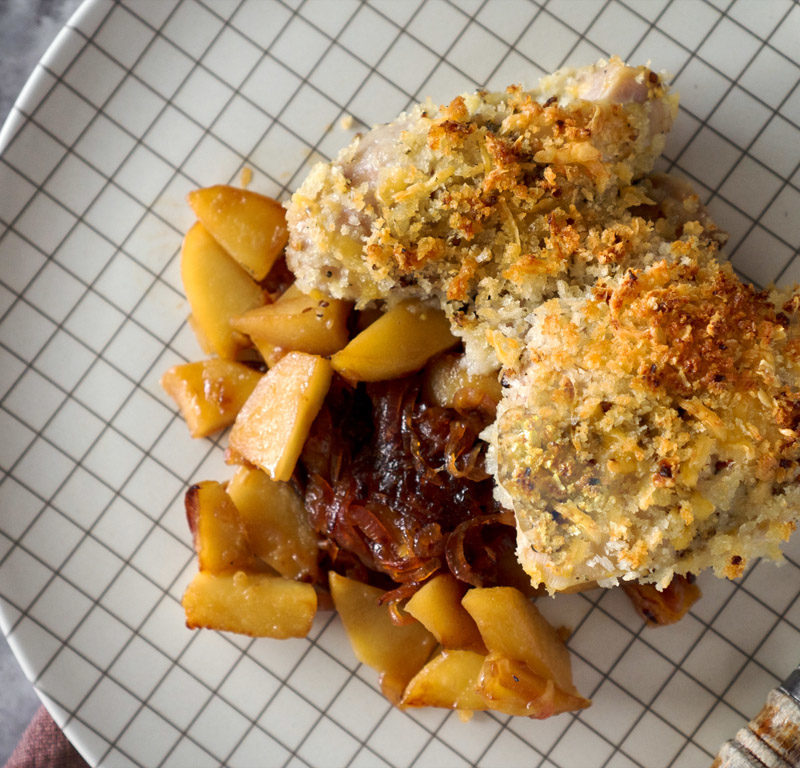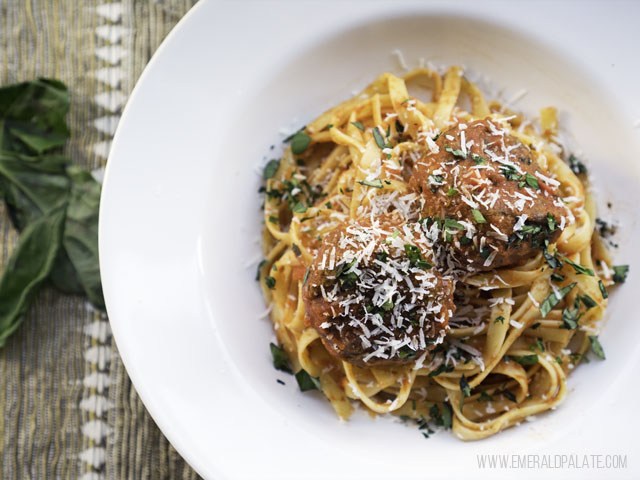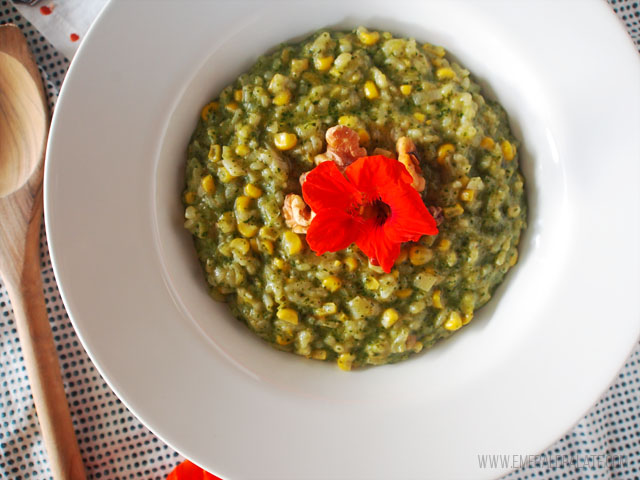
Easy Oven Risotto Recipe with Nasturtium Pesto & Corn
I discovered an easy oven risotto recipe via Bon Appetit magazine a while back and it changed my life. I had no idea you could make risotto in the oven. And I’d always resented the time-consuming, arm-breaking whisk job that risotto requires when made on the stove. But now, I could make it for a weeknight meal instead of only special occasions.
Over the years I kept coming back to that easy oven risotto recipe and playing around with different flavors and add-ins. I’ve been having trouble keeping up with my CSA this year because of all my travel so I had a ton of veggies I need to use: corn, leeks, carrots, and onion. I also had a prolific nasturtium plant in my front yard that was literally taking over my house. I found it growing inside my retaining wall!
Something had to happen. So when I was craving risotto I decided to turn to my trusty easy oven risotto recipe that I’d perfected over the years. The answer? A nasturtium pesto risotto with corn kernels and fresh corn stock. That’s right. Homemade stock. Don’t run, you can do it! As quickly as it takes you to prep everything else you need for this recipe. Find out how.
I am a big advocate of homemade stocks.
The flavor is unbeatable and you can freeze that stuff for months.
Yet I understand the hesitation when making animal stock. The best animal stocks require some pre-work, roasting the bones to get more flavor before boiling. Plus your house smells like meat for days. And the coagulated, foamy fat isn’t my favorite.
There are a lot of reasons you might avoid making meat stock and I get it. But luckily there’s absolutely not reason not to make corn stock. It is the easiest stock to make ever. You literally throw everything into a pot with water and there’s barely any chopping involved. It can be done in 30 minutes, or longer with no oversight if you want deeper flavor.
This recipe leaves you with about 2 cups of leftover corn stock for future use. It also has a ton of applications outside of this recipe. You can add it to homemade corn chowder, braised fish, or really any recipe that calls for stock. It’s a great way to impart corn flavor on any dish, or create a vegan or vegetarian-friendly dish with vegan stock.
What are nasturtiums?
Nasturtiums are a South American trailing plant, which means it spreads across the ground and doesn’t get very tall. They have green, lily pad-like leaves that are about 2-5″ wide and bright orange flowers. They also have large seeds that you can pickle to make homemade capers.

I discovered that I had a ton of nasturtiums in my front yard by accident. We had gotten landscape work done, where we thought the landscapers removed all the plants from the bed hugging our house since we were told by our inspector that it should be removed.
All of a sudden, these lily pad-like, vine-y plants started shooting up. Not just in that flower bed, but also in our beds in other areas of the front yard. I was freaked out that we had some kind of weed infestation because it was so prolific, so I told my new landscaper to remove them.
The day before my new landscapers came, I went to the now-closed The Willows Inn. During my meal there I had not one, but two dishes with nasturtiums in it. I was like, “Oh shit, they’re edible!”
The timing was perfect, because my landscaper said the next day that they were edible nasturtiums and help prevent weeds. She recommended I keep them. I could tell she thought I was going to fight it, but the timing was serendipitous. I’d already decided to keep them.
The funny thing is that nasturtiums are known for being an annual plant, meaning they only last one season and don’t grow back.
Yet, when we bought our house last year these plants existed in the beds. I distinctly remember because one day I came home to a mess of pods all over my walkway, in which I cleaned grumpily while cursing the plants. We’ll see if they come back next year. If they do, I may just have some kind of mutant perennial breed!
Nasturtiums are quite peppery, similar to arugula. They’re quite intense on their own, so I wouldn’t recommend eating a whole salad of them (like I typically do with arugula). If you do use them in salad, use them as an accent, like in my spring salad recipe.
What does this easy oven risotto recipe taste like?
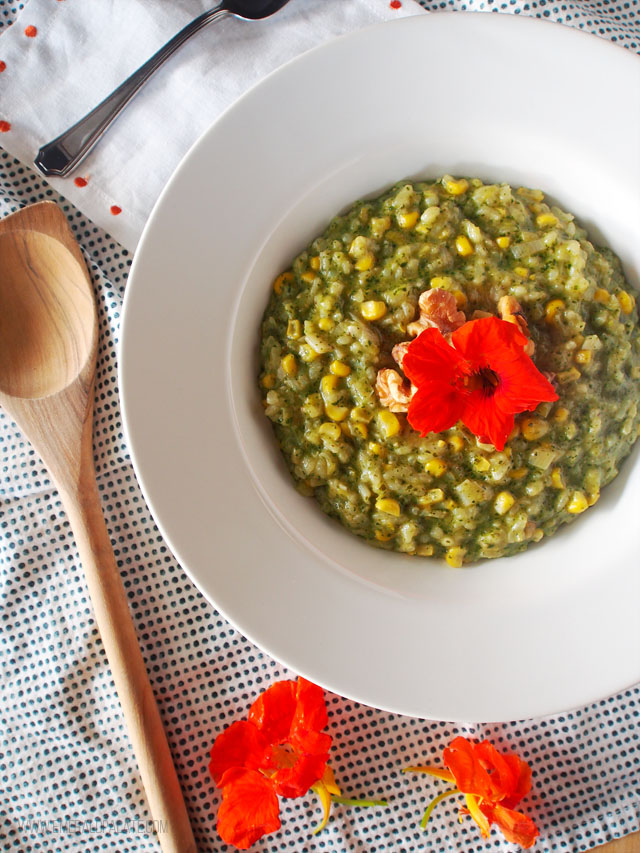
I love how easy oven risotto is. You don’t have to whisk for 30 minutes on the stove and you can still get that creamy, slightly gummy texture.
The predominant flavor is the corn thanks to the deeply-flavored corn stock and corn kernels. The pesto adds a subtle earthiness to balance the sweetness of the corn. You can also taste the umami from the cheese that comes through.
I highly recommend serving this with a nasturtium flower or two. It adds a bitter bite to counteract the sweet richness of this risotto. But it’s totally optional, especially if you want to savor that sweet corn taste.
The Risotto Recipe
Serves 4 | Active time: 40 mins | Total time: 75 mins
Ingredients
For the corn stock:
- 2 corn cobs, kernels removed and set aside
- 1 medium onion, cut into quarters
- 1 medium carrot, cut into 1-inch pieces
- 1 large celery rib, cut into 1-inch pieces
- Dark green leaves from 1 leek (set aside white and light green parts)
- 2 cloves garlic, smashed
- 1 tsp kosher salt
- 1 tsp whole black peppercorns
For the vegetarian risotto:
- 2 Tbsp extra virgin olive oil
- 1 medium leek, finely chopped (the reserved with and green parts from the stock)
- 2 cloves garlic, diced
- 1 C arborio rice
- Kosher salt and freshly ground black pepper
- ½ cup dry white wine
- 2 Tbsp unsalted butter
- 3 oz. Pecorino Romano, finely grated (about 2 cups)
For the pesto:
- ½ cup walnuts, coarsely chopped and divided
- 1 clove garlic
- 1/4 tsp salt
- 1 tsp. lemon zest
- 2 Tbsp lemon juice
- 2 C packed nasturtium leaves (can sub arugula instead)
- 1/3 C extra virgin olive oil
Directions:
Step 1
Make the corn stock: Combine all ingredients with 6 cups water in a large pot. Bring to a boil over high heat. Reduce heat so liquid is simmering; cover pot and let simmer for at least 30 minutes, up to a few hours. Strain through a fine-mesh strainer.
Step 2
Make the risotto: Preheat the oven to 350°F. Add walnuts to a baking sheet and bake until browned and fragrant, 8-10 minutes. Set aside.
Step 3
Heat extra virgin olive oil in a dutch oven. Add leek, 1/4 tsp salt, and 5 grinds from a pepper mill. Cook, stirring often, until softened and translucent, 5–8 minutes. Add garlic and cook until fragrant, 1 minute. Stir in rice; season with 1/4 tsp salt and another 5 grinds from a pepper mill. Cook, stirring, until some grains are translucent, about 5 minutes.
Step 4
Add wine, bring to a simmer, and cook until the pan is almost dry, about 3 minutes. Add reserved corn kernels, and 2 cups very hot corn stock; season with 1/2 tsp salt.
Step 5
Bring to a simmer, cover, and bake in oven until liquid is mostly absorbed but rice is still starchy in the center, 15–18 minutes (it should be undercooked).
Step 6
Meanwhile, make the pesto. Pulse 1 clove garlic and half of toasted walnuts in a food processor until very finely ground. Add nasturtium leaves, lemon zest, and remaining olive oil. Process until smooth. Season pesto with salt and pepper to taste.
Step 7
Take the risotto out of the oven and put it on the stove over medium heat. Add 2 cups hot corn stock and cook rice, whisking constantly, until it is tender but still has some bite and the sauce is creamy, about 3 minutes. Stir in the pesto, butter, and three-quarters of the Pecorino Romano cheese. Season with salt and pepper to taste, if needed. Serve topped with remaining walnuts, cheese, and nasturtium flowers. Enjoy!
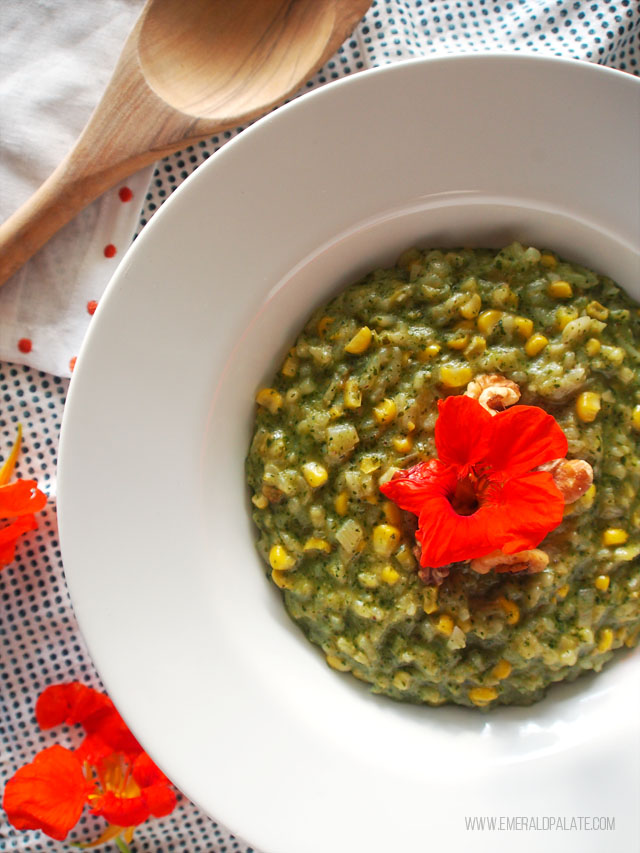
Nutritional Information Per Serving:
Calories: 630 | Calories from fat: 400 | Fat: 45.5 | Saturated fat: 11g | Cholesterol: 34mg | Sodium: 1,000mg | Carbs: 42.5g | Fiber: 1.7g | Sugars: 2g | Protein: 12g
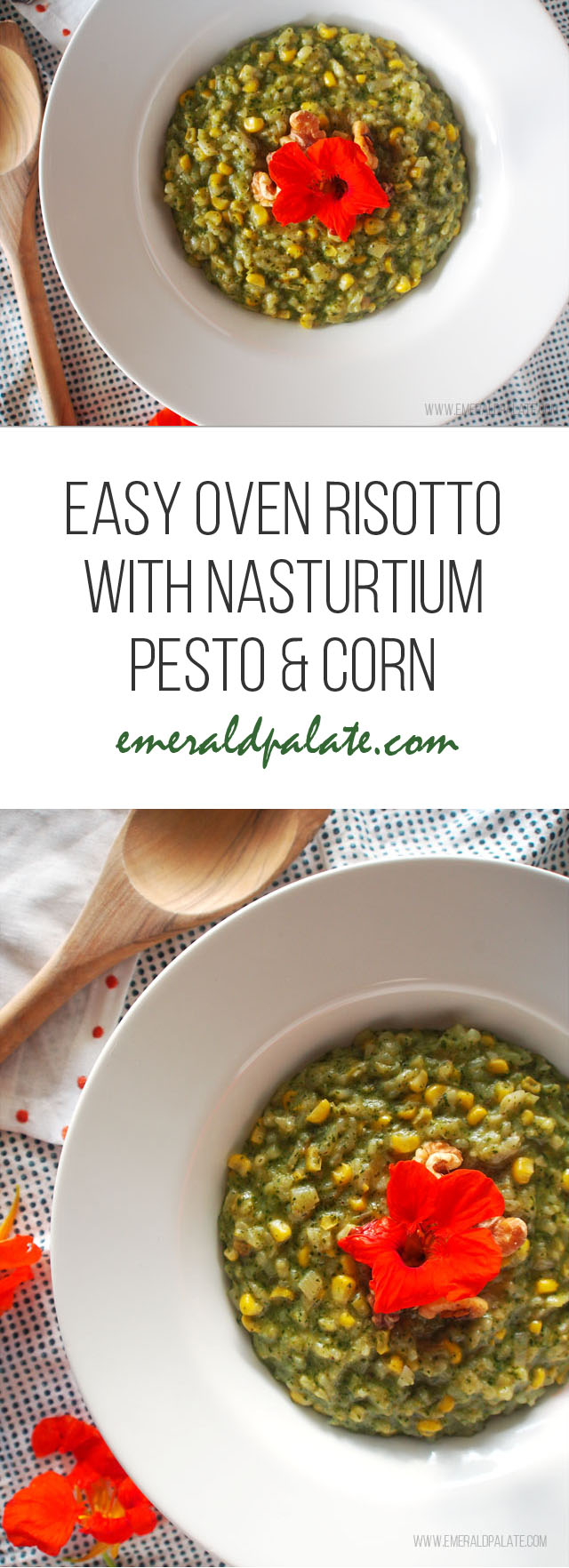
Nutritional Facts Disclaimer: I am not a registered nutritionist and therefore these numbers are approximate. I researched the serving sizes and facts for each ingredient in this recipe (mostly using the manufacturer labels and this site), but slight variations in things like seasoning, garnishes, and substitutions can change the nutritional information. Use this information only as a general indication of your nutritional intake.
